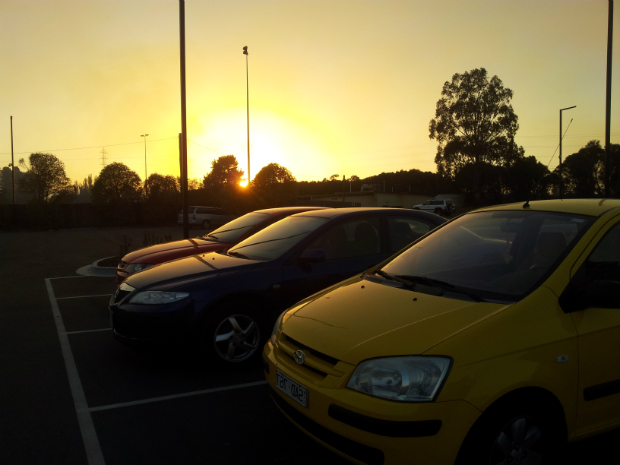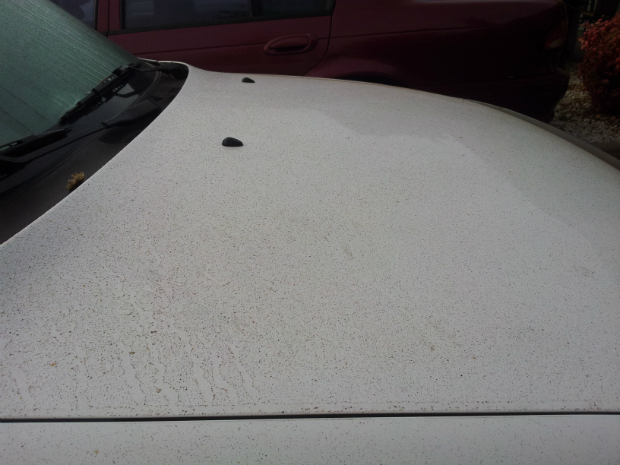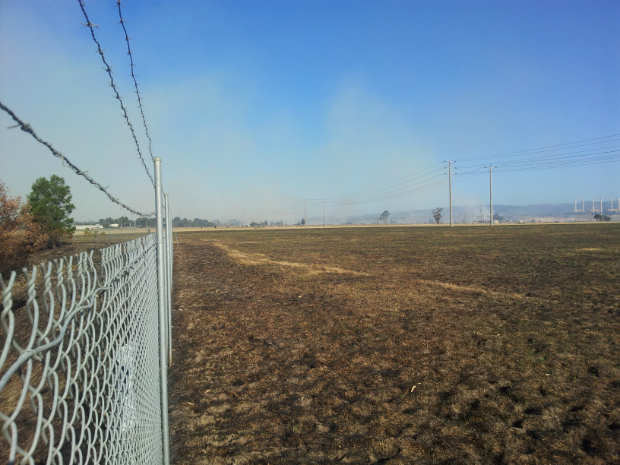On Friday night in Melbourne I bumped into Raku Pitt, who lives in Wollangarra, 100 kilometres north-east of Morwell. Pitt had driven through Morwell that afternoon, and was visibly shaken. He said it was “like Mordor”.
“There’s ash raining from the sky, a horrible stink in the air,” he told me. “The coal mine fire’s going to burn for weeks, it’s right next to town and no one knows what’s in the smoke. People are wearing face-masks, hiding in their houses — it’s like a zombie movie.”
On Sunday afternoon, I bought a face-mask and drove to Morwell to see it for myself.
A couple of kilometres out of town, the air turned grey. The tree trunks changed from brown to bright black, and the gum leaves were bleached a dirty ash-blond from last fortnight’s bushfires. Road-signs were still standing but the paint had burnt off, leaving them shiny and raw.
At 4:30pm, downtown Morwell was deserted — although, to be fair, it was a Sunday afternoon. Small grey chunks of ash blew out of the sky like dirty anorexic snowflakes; it smelled like a bad barbecue. The first person I saw on the streets wasn’t wearing a face-mask; he ambled out of Morwell Station, sat down on a bench and slowly rolled a cigarette.
At the CFA information bus in the Mid Valley Shopping car park, Belgrave South CFA member Alan Dixon was handing out face-masks and reassuring locals that everything was fine. However, he was also telling residents that, if possible, they should leave town and stay with friends or family elsewhere.
Dixon said the fire-fighters were doing their best, but it could take weeks, even months, to put the fire out. He gave me a face-mask and advised me not to spend the night in downtown Morwell, where the smoke was worst. I considered putting on the mask, but since the CFA staff weren’t wearing them, I didn’t either.
EPA Environmental Protection Officer Mel North said that the fire was either started by a lightning strike, or by an arsonist — investigations were underway. However, any discussion of the causes of the fire misses the point: the Hazelwood open-cut coal mine was an accident waiting to happen.
As North informed me, one of the parts of the coal mine that was now quietly ablaze had been disused for 10 years. However, locals are alleging that the owners of the mine, GDF SUEZ Energy International, had failed to rehabilitate the land.
A number of Morwell residents told me that GDF Suez had not “capped” the old mine site with clay so that the coal was no longer exposed. They had not revegetated the area, so that any fire would pass through above rather than below ground. And they had not installed a sprinkler system as an interim plan while waiting to put in place more permanent measures. I put these allegations to GDF and got no reply.
I asked North if the EPA knew what was in the smoke; she said that scientists were currently conducting tests. When pressed for details, she became defensive and asked me if I was a journalist working on Monash Arts Online’s Dangerous Ground project.
Dangerous Ground, a website that investigates environmental regulation, had severely embarrassed the EPA back in 2008, when a methane gas leak from an old landfill site in suburban Cranbourne led to widespread evacuations at the nearby Brookland Greens housing estate. A 2011 Ombudsman’s Report concluded the that “the EPA failed to protect the environment from […] 1992 to June 2008.”
While North told me that the EPA had yet to find anything conclusive in their tests of the smoke around Morwell, an ABC report two days earlier confirmed that the Authority had “confirmed traces of metal in the air, and some other particles as well […] including nitrogen and sulphur”. However, the EPA told the ABC that these contaminants were “not at levels considered harmful”.
The primary concern of both the CFA and the EPA in Morwell seemed to be minimising public alarm, rather than providing detailed information. A common refrain went along these lines: “I’m not wearing a mask; if it was really dangerous, do you think I’d be standing out here?” However, most of the emergency services staff I talked to did not live in Morwell. They were working there for a few days before returning to their homes elsewhere.
At the Morwell Bowls Club, business was slow on a Sunday night — 10 diners in a bistro that seats close to 80. The Bowls Club is only 500 meters away from the fires, which made for bad air but striking sunsets.

The bartender said that all the Bowls Club staff had been offered face-masks that morning, but she wasn’t wearing hers. “That’d scare the customers away, wouldn’t it?” she said.
“Good point,” I said. “It’d be like eating in a hospital.” I had a parma. As I left, the bartender called out “Come back when it’s clear!”
I slept badly. The next morning I felt tired and groggy, as if I’d smoked half a packet of cigarettes the night before. I went to the bathroom and started coughing up bright green phlegm. Outside, the ash was thick on car bonnets and windshields. A Cedar Lodge employee was hosing off the plants in the garden. As one wit tweeted, “Morwell smells like a briquette broke wind”.

Inside the St Vincent de Paul thrift shop, everyone was coughing and complaining about their health.
“They told me not to turn my air-conditioning on,” one elderly customer said. “It brings more stuff in. But I was desperate, so I turned it on. It helped a little.”
Unfortunately, while the woman’s air conditioner might filter the larger chunks of coal-ash, it will not filter PM2.5 particles, which are less than 2.5 microns wide (there are 10,000 microns in a centimetre) and are of significant concern to older people.
According to Chief Health Officer Rosemary Lester, PM2.5 particles “can cause short-term health effects”, but the long-term health effects aren’t known. When asked by a reporter if this was because of a “knowledge gap”, Lester replied: “There isn’t a complete knowledge gap.”
According to the Australian Government’s Department of Environment website:
“Studies have linked exposure to particle pollution to a number of health problems including respiratory illnesses (such as asthma and bronchitis) and cardiovascular disease. In addition, the chemical components of some particles, particularly combustion products, have been shown to cause cancer. These effects are often more pronounced for vulnerable groups, such as the very young and the elderly.”
This calls to mind a line from Frederick Buell’s book, From Apocalypse to Way of Life: “risk calculations mean that a certain number of individual people are likely to subsidize industry with their lives”.
A “respite centre” has been set up in Moe. However, a Salvation Army volunteer described the centre as a joke. “You can’t stay there overnight, it’s only open from 9am till 7pm," the volunteer said. "So you drive there, sit on a wooden chair all day doing nothing then drive home again. I’d rather stay at home, at least I can watch TV.”
Another local said that the “fallout” from the fires would likely hang around for years. They suggested that a class-action lawsuit might be taken against GDF SUEZ Energy International — a suggestion that was echoed yesterday by the ABC.
This would be similar to earlier class actions in Morwell against the Hazelwood power station, which was once riddled with asbestos and still contains, according to International Power Hazelwood spokesperson Neil Lawson, “an amount of contained asbestos material”. “Contained”, that is, as long as the power station itself doesn’t burn to the ground.
In the Latrobe Regional Gallery, all the staff were wearing face-masks.
“Of course I’m wearing a face-mask,” one worker said, “I’ve been wearing a face-mask since last Monday! I live out of town and I get to work and in half an hour I’ve got a headache. If you’re not wearing one you’re crazy.”
Despite the gallery’s best efforts, ash was getting in under the doors and affecting the artworks.
In the gallery’s café, I overheard locals talking about out-of-town journalists sniffing around. “A TV crew came to my neighbour’s house, asking him questions, taking pictures,” one said. “Then he came over to me, asked if I wanted to talk to him. Why would I want to talk to him? Why would I want to be on telly?”
Minutes later, an elderly man collapsed outside Morwell Station. Three paramedics attended to him, preparing to load him into an ambulance. It wasn’t clear whether the man was suffering from respiratory problems — and if so, whether the coal smoke had “caused” his collapse.
The mood in Morwell was a mixture of panic and frustration, resignation and outrage. Some townspeople see the recent media interest in the “firebug” story as a way of diverting attention from the real story: corporate negligence and government nonchalance.
A rally is planned at 2pm this Sunday, outside Morwell’s Kernot Hall. The protest is called Disaster In The Valley — Dying For Help, and the Facebook event page states:
“It has come to light that this part of the mine was supposed to be capped and re-mediated to prevent fire … but it was not. It has come to light that there should have been fire safety infrastructure in place while the coal was exposed … but it was not.”
The rally is scheduled to take place outside; people are being encouraged to “make it cool to wear the face-masks” by decorating the masks in kooky or political ways.
I left Morwell on Monday afternoon. The Princes Freeway takes you right past the fire. No flames are visible, but there is a long, low smoking cliff face. A couple of kilometres to the west there is a field of scorched black grass leading under a protective fence, all the way to the mine.

In other words, GDF Suez left a huge wall of flammable coal exposed to the elements in a fire season. If anything, Morwell might well be fortunate that a similar mine fire hasn’t broken out earlier.
I took photographs with my phone until I started coughing, then got into my not-so-white car and drove back to the big smoke. By Wednesday, I was coughing and my phlegm had blood in it. I probably should have worn that face mask.
GDF did not respond to questions from the author by deadline.
Donate To New Matilda
New Matilda is a small, independent media outlet. We survive through reader contributions, and never losing a lawsuit. If you got something from this article, giving something back helps us to continue speaking truth to power. Every little bit counts.



